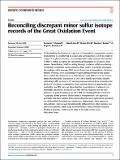Reconciling discrepant minor sulfur isotope records of the Great Oxidation Event
Author(s)
Uveges, Benjamin T; Izon, Gareth; Ono, Shuhei; Beukes, Nicolas J; Summons, Roger E
DownloadPublished version (1.109Mb)
Publisher with Creative Commons License
Publisher with Creative Commons License
Creative Commons Attribution
Terms of use
Metadata
Show full item recordAbstract
<jats:title>Abstract</jats:title><jats:p>Understanding the timing and trajectory of atmospheric oxygenation remains fundamental to deciphering its causes and consequences. Given its origin in oxygen-free photochemistry, mass-independent sulfur isotope fractionation (S-MIF) is widely accepted as a geochemical fingerprint of an anoxic atmosphere. Nevertheless, S-MIF recycling through oxidative sulfide weathering—commonly termed the crustal memory effect (CME)—potentially decouples the multiple sulfur isotope (MSI) record from coeval atmospheric chemistry. Herein, however, after accounting for unrecognised temporal and spatial biases within the Archaean–early-Palaeoproterozoic MSI record, we demonstrate that the global expression of the CME is barely resolvable; thereby validating S-MIF as a tracer of contemporaneous atmospheric chemistry during Earth’s incipient oxygenation. Next, utilising statistical approaches, supported by new MSI data, we show that the reconciliation of adjacent, yet seemingly discrepant, South African MSI records requires that the rare instances of post-2.3-billion-year-old S-MIF are stratigraphically restricted. Accepting others’ primary photochemical interpretation, our approach demands that these implied atmospheric dynamics were ephemeral, operating on sub-hundred-thousand-year timescales. Importantly, these apparent atmospheric relapses were fundamentally different from older putative oxygenation episodes, implicating an intermediate, and potentially uniquely feedback-sensitive, Earth system state in the wake of the Great Oxidation Event.</jats:p>
Date issued
2023-01-17Department
Massachusetts Institute of Technology. Department of Earth, Atmospheric, and Planetary SciencesJournal
Nature Communications
Publisher
Springer Science and Business Media LLC
Citation
Uveges, Benjamin T, Izon, Gareth, Ono, Shuhei, Beukes, Nicolas J and Summons, Roger E. 2023. "Reconciling discrepant minor sulfur isotope records of the Great Oxidation Event." Nature Communications, 14 (1).
Version: Final published version